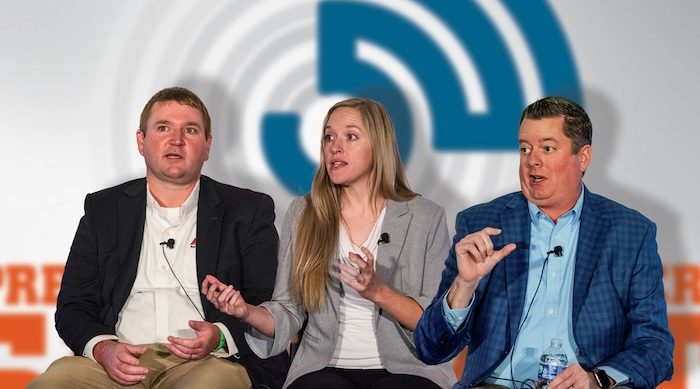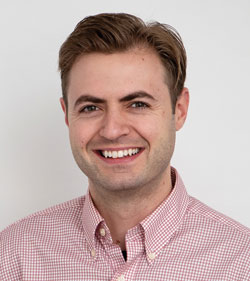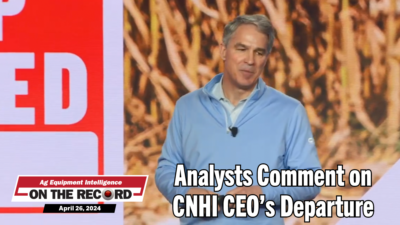The precision ag heads at AGCO, Case IH and New Holland each shared their strategic direction for business at the 2024 Precision Farming Dealer Summit in Indianapolis, Ind. Jeffrey Smith, product marketing manager for AGCO, Kendal Quandahl, precision field team manager for Case IH, and Paul Welbig, precision technology product marketing director for New Holland North America, discussed the realities of precision services in dealerships, the successful approaches embraced by their top-performing dealers and what to expect in the autonomy space. Here are some highlights from the conversation.
What separates your top performing precision ag dealers from the rest of the pack?
Smith: Our top performers really give technology an integrated place in their dealership. Their salespeople are knowledgeable about precision technology, and their people at the counter are as well. They have a leader who recognizes you can’t just put one person in a truck, tell them they’re the precision specialist, and make them responsible for everything technology related at the dealership. Then beyond that, the top dealers are also planning demo days that are focused on new technology, as opposed to pushing it to the background.
“The top dealers are accepting that they may not know their customer as well as they think they do…”
Quandahl: When I think about the dealers who have really floated to the top, the one thing that really stands out is their overall dedication to embracing change. We know that technology is not the same as it used to be and that our customers are not the same. But the top dealers are accepting that they may not know their customer as well as they think they do today. They’re making a dedicated effort to visit with their customer base and learn what solutions they’re needing from the dealership.
Welbig: They have a passion for really helping growers improve their operations. Train the trainer. That’s been the prolific philosophy of our most successful dealers. It shouldn’t just be the precision guy’s job to make everything work. It’s a team effort. The top dealers have some level of information sharing within the sales staff and other key areas of the organization. The precision team can still be the experts, but there are basic things that can be communicated to customers, without having to rely on the most technical person in the room to do so.
What initiatives have been put into place at the manufacturer level — products or programs — that should increase the effectiveness, efficiency and economic viability of precision ag support to the customer?
Welbig: It’s all about making the technology a little more approachable and having the support infrastructure in place as customers try to adopt, not just when things go wrong but also coaching them through the adoption curve a little bit. From a New Holland perspective, we’ve continuously invested resources in training and in-field support.
Quandahl: We’re trying to simplify the precision offerings. There will be a lot of communications over the next several months about the addition of factory fit technology and helping package that together for our dealers’ different customer bases. So, when they order a machine, there’s more standard tech features that we know are going to be associated with that machine included in the purchase. That would eliminate the hurdle of trying to then track down, “Does this have X, Y, Z activation subscriptions?” And that makes that administrative task inside the dealership a lot less impactful. You would have an expectation of what tech the machine comes with.
Smith: We have a program called the Precision Ag Line (PAL). PAL provides us a platform to provide support to both dealers and customers. It’s essentially a hotline that our dealers can contact, and customers can call in for support as well. We’re not service people, but we can provide operational support. So, if a salesperson is out with a customer, and they’re not sure which button to press, we have people on staff that can provide support. We’re scaling that up now. We’ve added additional headcount within the last 12 months and doubled the number of resources. It’s important for us to make sure the dealer feels that they’re backed by us.
Are more operators preferring equipment with OEM technology installed from the factory, or are they buying basic equipment, knowing they will purchase third-party technology to install later?
Smith: For us, it’s a combination of both. For the most part though, anything that we can integrate at the factory level makes it much easier for the manufacturer to provide support to that customer. And, as dealers, it really gives you that full package of support that you’re providing to the customer if you’re selling them the machine and the technology that comes with it.
“We’re aiming to have retrofit solutions for autonomy by 2025…”
Quandahl: There’s always going to be a need for that third-party or dealer installed precision solution. I don’t think that necessarily ever goes away. As more technology is released, there’s always going to be an opportunity for an aftermarket introduction. But the more we can include with the purchase of the machine, the better. That’s important because a lot of our customers see the iron and the technology as one unit. It makes the customer experience a lot more seamless.
Welbig: I agree with both of my colleagues about factory fit and retrofit. You don’t have to wait for the next big machine purchase to reap the benefits of the technology. I would just add that the factory integrated technology increases the value of the equipment on the secondary market. Chances are if a machine comes back to you without guidance on it, it’s going to be the last machine you sell out of your used inventory.
What are you doing to make sure the smaller acreage farms can afford technology?
Quandahl: Balancing the product availability. Being able to roll that factory fit offering into the wholesale purchase is going to be the easiest way for customers to handle that technology cost. The flip side to that is, the customer that isn’t ready to purchase a new piece of equipment but is interested in the technology. And having that balance between factory and an aftersales installation process, I think is something that is critical to balancing technology adoption across all farms.
Smith: We’re making sure that technology is accessible from the factory. It really drives affordability when a customer can roll that into his financing on the machine. Also, it’s important to give them opportunities or building blocks toward further technology adoption. Maybe they start with guidance on a mid-sized tractor from the factory, but they also have the building blocks to get into rate and section control if they want to.
How do your organizations make the distinction between autonomy and automation?
Quandahl: We follow the path to autonomy, and automation is part of that. To achieve a true autonomy solution, we must be able to automate all those individual tasks that a customer has to do today. There’s an opportunity to break down all those individual pieces and put that automation in the market. It will help customers learn and build confidence in the solution. If a customer is going to send a tractor and a piece of tillage equipment into the field without someone in the cab, they have to trust not only the connectivity, but they have to trust the automated turn row feature. They have to trust that the Soil Command prescription is going to execute as they’ve assigned it to. If you think about it like a puzzle, they’re all individual pieces, and when you complete the puzzle, that’s probably autonomy in a lot of cases, but we’ve got a lot of little pieces to get there.
What You Need to Know About Your OEM’s Precision Vision
Click here to watch a panel discussion featuring Kendal Quandahl, Paul Welbig and Jeffrey Smith at the 2024 Precision Farming Dealer Summit. The video replay is sponsored by Susterre.
Welbig: We’ve heard loud and clear from our customers, and we are very autonomy-forward and really going for the ultimate solution with driverless technology. Many customers we’ve interacted with basically said, “This is great. We’d love to get to this as soon as possible. But can we just take some of this technology and put a less experienced operator in our cab who could still do a lot of these functions?” That’s a good point, we realized, so we took a bit of a step back. There’s been a slight shift of where we’re heading to what we’re providing today, but we’re still on the path toward the ultimate goal of driverless technology.
Smith: At AGCO, we’re aiming to have retrofit solutions for autonomy by 2025 and full cycle solutions by 2030. If you look at what we’ve done in terms of development over the last few years, it’s been about putting the features and functions in place that are automated that allow us to build to that full level of autonomy. We’re making sure all our machines come from the factory with IoT devices that provide connectivity.
How long do you think it will take to get to 15% on-farm adoption for autonomy?
Welbig: That’s the magic question. It depends on a lot of factors. I can’t predict the customer behaviors, but I think it starts with certain applications. Things like tillage, spraying, and fertilizer application can benefit from autonomy.
Smith: It’s difficult to predict the timeline, but one thing we must consider is the lack of connectivity in a lot of the areas we serve. Bill Hurley from AGCO and the Assn. of Equipment Manufacturers (AEM) promoted a bill that would provide both financing opportunities for technology and rural broadband access. That’s a big piece. As they were preparing the bill, they looked at a study that estimated only 25% of farms have the connectivity required to provide full-scale solutions. That’s a big hurdle that must be cleared to get to that 15% adoption rate or higher.
“We rarely have conversations that aren’t focused on technology…”
Quandahl: I’m going to go a bit rogue on this question. I don’t think it’s necessarily going to be the delivery of a specific technology that takes us from 5% to 15% and beyond. I think it’s going to be the readiness of our OEM field staff and our dealer networks to be able to sell and support those autonomy solutions. As of today, the technology we have that will support autonomy is going to be focused on connectivity. You’re going to have to be able to access that piece of equipment from a remote location and have the uptime to see exactly what’s happening. This means we must have both a dealership structure and a company structure that supports being able to do that. When the technology hits, it’s going to be hard and fast. If we can’t support it, that will be the biggest limiting factor that we have in reaching significant adoption levels.
Do you view your company as a technology company or an equipment company?
Smith: I think we’re probably a little biased, but I can certainly see that shift to technology. If you just look at acquisitions over the course of the last couple years, it’s really driving technology and improvements in our technology stack. We’re rarely on calls or conversations that aren’t focused on technology in some way.
Quandahl: There’s a lot of technology that we’re coming out with that’s definitely tractor, combine and sprayer platform related, and I think that should get credit in the technology bucket as well. I think the technology company over iron company concept becomes a mindset. We’re certainly still an OEM, but we have to think about technology in a different light than we did 5-10 years ago. We have to adapt to have that tech-focused mindset, whether that’s precision technology or technology that’s improving a piece of equipment.
Welbig: I agree on all fronts. It’s an evolution, not a destination. I think of the analogy around the automotive space — are they cars or glorified computer systems? It’s hard to distinguish between the 2 sometimes. I think that’s the ultimate reality of where we are and where we’re headed. The sky’s the limit as far as where we go in the future.








Post a comment
Report Abusive Comment